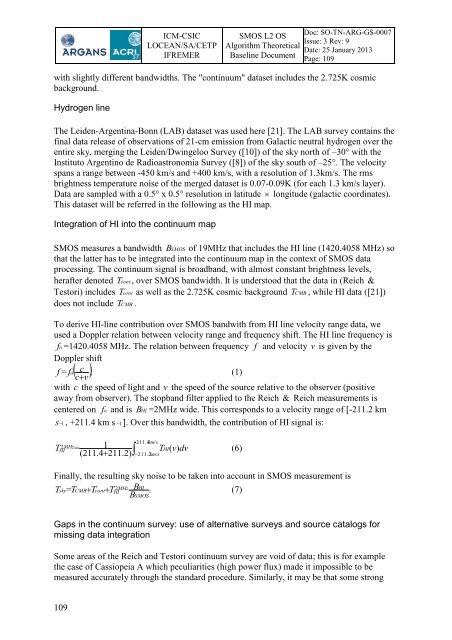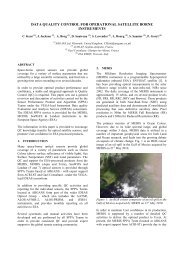SMOS L2 OS ATBD - ARGANS
SMOS L2 OS ATBD - ARGANS
SMOS L2 OS ATBD - ARGANS
Create successful ePaper yourself
Turn your PDF publications into a flip-book with our unique Google optimized e-Paper software.
109<br />
ICM-CSIC<br />
LOCEAN/SA/CETP<br />
IFREMER<br />
<strong>SM<strong>OS</strong></strong> <strong>L2</strong> <strong>OS</strong><br />
Algorithm Theoretical<br />
Baseline Document<br />
Doc: SO-TN-ARG-GS-0007<br />
Issue: 3 Rev: 9<br />
Date: 25 January 2013<br />
Page: 109<br />
with slightly different bandwidths. The "continuum" dataset includes the 2.725K cosmic<br />
background.<br />
Hydrogen line<br />
The Leiden-Argentina-Bonn (LAB) dataset was used here [21]. The LAB survey contains the<br />
final data release of observations of 21-cm emission from Galactic neutral hydrogen over the<br />
entire sky, merging the Leiden/Dwingeloo Survey ([10]) of the sky north of –30° with the<br />
Instituto Argentino de Radioastronomia Survey ([8]) of the sky south of –25°. The velocity<br />
spans a range between -450 km/s and +400 km/s, with a resolution of 1.3km/s. The rms<br />
brightness temperature noise of the merged dataset is 0.07-0.09K (for each 1.3 km/s layer).<br />
Data are sampled with a 0.5° x 0.5° resolution in latitude longitude (galactic coordinates).<br />
This dataset will be referred in the following as the HI map.<br />
Integration of HI into the continuum map<br />
<strong>SM<strong>OS</strong></strong> measures a bandwidth B <strong>SM<strong>OS</strong></strong> of 19MHz that includes the HI line (1420.4058 MHz) so<br />
that the latter has to be integrated into the continuum map in the context of <strong>SM<strong>OS</strong></strong> data<br />
processing. The continuum signal is broadband, with almost constant brightness levels,<br />
herafter denoted T cont , over <strong>SM<strong>OS</strong></strong> bandwidth. It is understood that the data in (Reich &<br />
Testori) includes T cont as well as the 2.725K cosmic background T CMB , while HI data ([21])<br />
does not include T CMB .<br />
To derive HI-line contribution over <strong>SM<strong>OS</strong></strong> bandwith from HI line velocity range data, we<br />
used a Doppler relation between velocity range and frequency shift. The HI line frequency is<br />
f o =1420.4058 MHz. The relation between frequency f and velocity v is given by the<br />
Doppler shift<br />
= ,<br />
c v<br />
c f fo<br />
(1)<br />
<br />
with c the speed of light and v the speed of the source relative to the observer (positive<br />
away from observer). The stopband filter applied to the Reich & Reich measurements is<br />
centered on f o and is B HI =2MHz wide. This corresponds to a velocity range of [-211.2 km<br />
s 1<br />
, +211.4 km s 1].<br />
Over this bandwidth, the contribution of HI signal is:<br />
km s<br />
T MHz<br />
HI<br />
THI(<br />
v)<br />
dv<br />
(211.4 211.2) km s<br />
1<br />
211.4 /<br />
2 =<br />
211.2 /<br />
Finally, the resulting sky noise to be taken into account in <strong>SM<strong>OS</strong></strong> measurement is<br />
=<br />
2 HI<br />
sky CMB cont<br />
MHz<br />
HI .<br />
B<strong>SM<strong>OS</strong></strong> B<br />
T T T T<br />
(7)<br />
Gaps in the continuum survey: use of alternative surveys and source catalogs for<br />
missing data integration<br />
Some areas of the Reich and Testori continuum survey are void of data; this is for example<br />
the case of Cassiopeia A which peculiarities (high power flux) made it impossible to be<br />
measured accurately through the standard procedure. Similarly, it may be that some strong<br />
(6)



